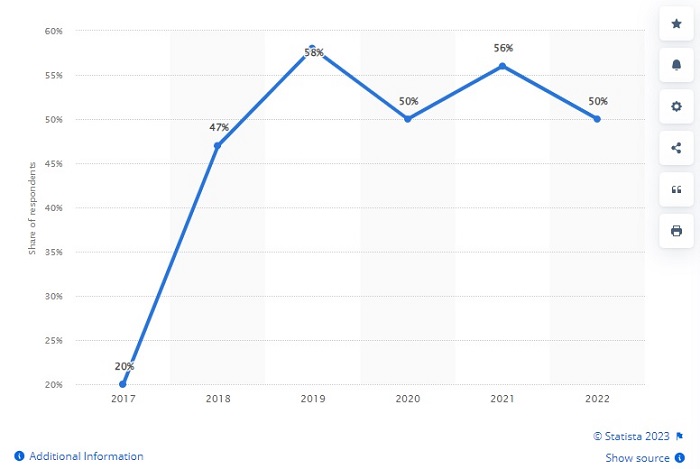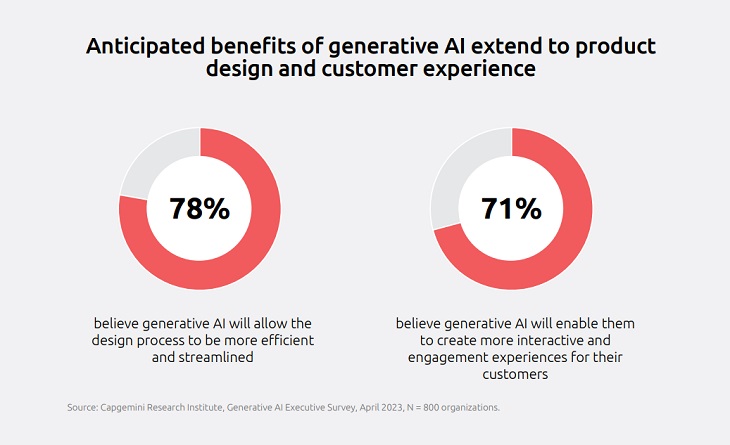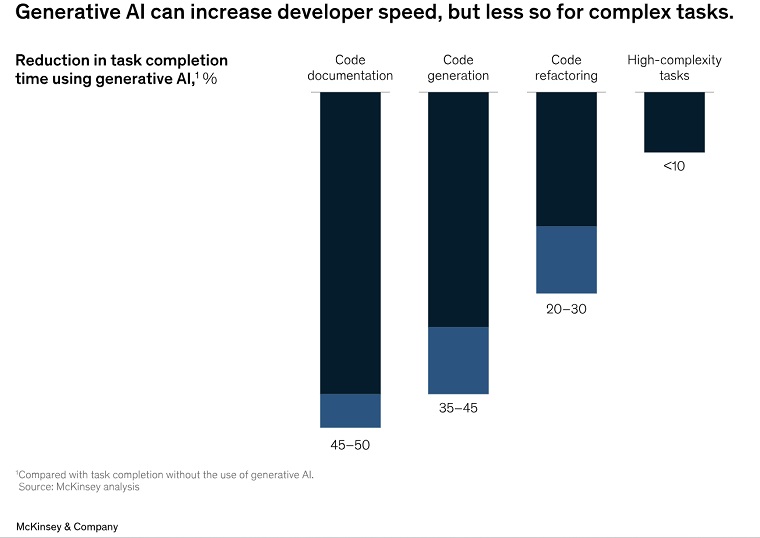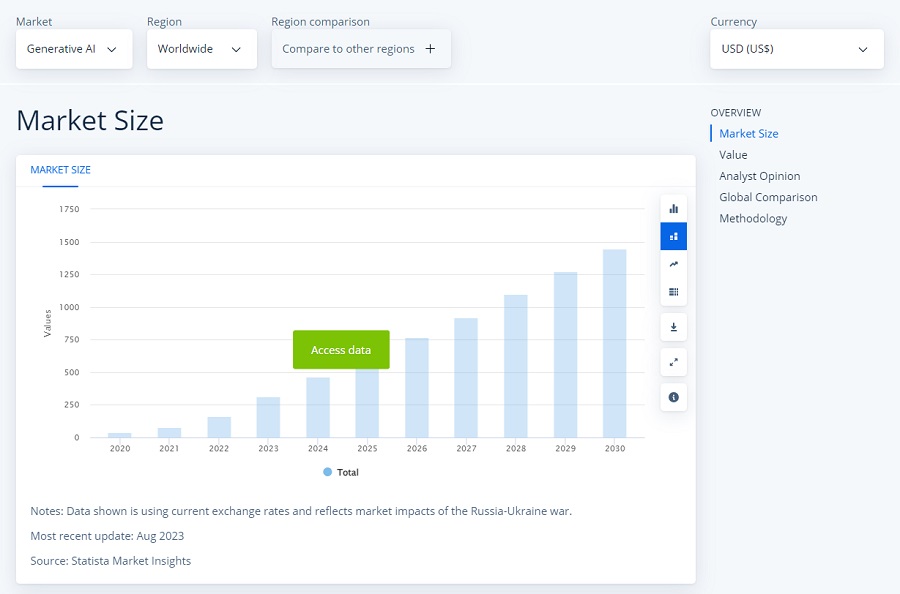If you’ve been curious about how the generative AI technology is currently playing out in the global market, the following is an ultimate list of interesting statistics to keep you well informed.
Featured photo by: Possessed Photography on Unsplash
Table of Contents
• Generative AI Adoption Stats
• Generative AI Productivity Stats
• User Trust Statistics in Generative AI
• Generative AI Software Statistics
• ChatGPT Statistics
• Statistics on Generative AI Art
• Market Growth & Economic Potential of Generative AI
• My thoughts on Generative AI
Generative AI Adoption Stats
Adoption of generative AI technology is rapidly gaining traction across industries.
Here are some numbers that show who use it the most and what the adopters found.

• Gen Z or Millennials make up 72% of users of generative AI, and 65% of them have jobs – Salesforce
• 68% of the Gen X (Baby Boomers) are non-users – Salesforce
• The highest levels of AI adoption at approximately 60%, were seen in Chinese and Indian businesses – IBM
• 37% of users working in marketing or advertising in the US have used generative AI for work-related tasks – Statista
• More than half of marketers use generative AI to generate text, video, and audio – Botco Insights
• 44% of users say there’s a significant difference between human-generated content and chatbot-generated content – Forbes Advisor
• To date (Oct. 2023), NewsGuard has identified more than 510 websites with ‘unreliable’ AI-generated news that produced false narratives – NewsGuard
Generative AI Productivity Stats
Is generative AI showing promising results in terms of productivity?
You’ll find the answers below.

• Marketers predict generative AI will save them 5.0 hours of work per week – Salesforce
• 54% of organizations that are using AI saw cost-saving and increased efficiency in IT, business and network processes – IBM
• A Fortune 500 software company’s customer service workers found that deploying generative AI tools increased productivity by an average of 14% – National Bureau of Economic Research
• The least skilled workers benefited the most as they completed their work 35% faster – National Bureau of Economic Research
• 69% of executives believe that AI will result in the creation of new job roles – Capgemini Research Institute
• 67% of executives say that generative AI helps drive innovation and create value the most for IT, sales and marketing – National Bureau of Economic Research
• Generative AI could allow marketing and communications organizations to reach their customers more effectively – Capgemini Research Institute
• In three years from now, generative AI is anticipated to increase operational efficiencies and consumer satisfaction by 9% – Capgemini Research Institute
User Trust Statistics in Generative AI
It looks like the level of trust in generative AI tools varies.
Here’s a look at what the numbers say about how much people trust AI.
• 76% of consumers are concerned about inaccurate information from generative AI products – Forbes Advisor
• 73% of global consumers say they trust contents created by generative AI – Capgemini Research Institute
• However, Western nations were the least willing to trust and embrace AI across personal and private space – Statista
• 60% of adult men and 40% of adult women in the US strongly trust generative AI. They are mostly millennials who have not finished college – Insider Intelligence
• 66% of US adults are concerned about privacy issues involving the use of generative AI for social media – Insider Intelligence
• 67% of consumers think that getting medical advice from generative AI would be beneficial for them – Capgemini Research Institute
• Geographically, trust in AI is far higher in developing countries and among those under 40 – Ipsos
Generative AI Software Statistics
On the software side of things, I have found the following stats to be pretty mind-blowing.

• A whopping 92% of U.S based developers are already using generative AI coding tools both in and outside of work – Github
• 60% of the design work for new websites and mobile apps will be automated by generative design AI by 2026 – Gartner
• According to an Aira 2022 survey of marketers worldwide, 58.9% have used generative AI writing tools to optimize existing contents to outperform competitors’ copy – Insider Intelligence
• In just three years, VC companies have invested more than $1.7 billion in generative AI, with software coding and AI drug discovery garnering the most funding – Gartner
• To support ChatGPT, OpenAI required 3,617 servers with a total of 28,936 graphics processing units (GPUs), resulting in a power consumption of about 564 MWh per day, thus raising environmental concerns – TheStar, SemiAnalysis
ChatGPT Statistics
I’m sure most of you are curious about how ChatGPT is currently impacting people around the world, especially those who are using it.
The interest level was definitely high, and here’s what I found.

• Of the people who are using ChatGPT, 86% find it helpful as the versatility of the program allows it to be applied to a wide range of use cases – GWI
• Within the first month of ChatGPT’s debut, 27% of industry professionals used it for work. Respondents included executives from Amazon, JP Morgan, Meta, Nike, Bank of America, Google, IBM, Twitter/X, and other companies. – Fishbowl Survey
• 46% of users are concerned that ChatGPT is a biased tool – GWI
• 68% of ChatGPT users would prefer it over a search engine to request for information – GWI
• Almost half of ChatGPT users are willing to pay for a premium version – GWI
Statistics on Generative AI Art
If you’re a creative professional, you wouldn’t want to miss knowing the stats surrounding generative AI art.
It’s fascinating to see how this technology is being embraced and utilized in the art world.

• AI art first emerged in 2021 with the release of DALL-E by OpenAI in January 2021. It was soon followed by Midjourney and Stable Diffusion – TechTarget
• 31% of those who are familiar with AI image generators regard them as a big development in visual arts – World Economic Forum
• According to Google Trends, search interest for “AI art” peaked in December 2022 – Google Trends
• In May 2023, MidJourney’s website had the highest traffic with 35.5 million visitors – MSpoweruser
• Midjourney attracts around 90,000 members daily, with a predominantly male (64%) user base – ContentDetector.AI
• More than 50% of people can still tell when art is AI-generated – Yale Daily News
• Reddit’s AI community were far better able to distinguish real images from AI images – Tidio
• The majority of AI art generators are trained on the LAION-5B dataset, which has 5.85 billion images – LAION
• Artists indicated that if their artwork is used to train AI algorithms, 72.6% want to be compensated, and 53.5% want to be credited – Book An Artist Survey
Market Growth & Economic Potential of Generative AI
As this technology continues to advance, it is expected to open up new opportunities and industries, driving innovation and economic growth.
Though there are concerns about the unethical use of generative AI, the statistics show a promising trend.

• The generative AI market size is growing at an annual rate of 24.40% and is expected to reach US$207 billion by 2030 – Statista
• The companies currently leading the global generative AI market are Google (US), IBM (US), Microsoft (US), Adobe (US), Amazon Web Services (US), Synthesis AI (US), Nvidia Corp (US), SAP SE (Germany), Accenture (Ireland) and Rephrase.ai (US) – Yahoo! Finance
• The potential for generative AI to boost productivity is growing significantly with the advancement of machine learning and deep learning – McKinsey Insights
• The productivity impact of generative AI could add trillions of dollars to the global economy – McKinsey Insights
• Four industries stand to benefit most from generative AI use cases. They are: customer operations, marketing & sales, software engineering, and R&D – McKinsey Insights
My thoughts on Generative AI
I hope you find the above list of stats insightful. I’ll be updating this post regularly to keep you informed about the latest developments in the AI space.
So far, it’s evident—all of the data indicate that generative AI is advancing and revolutionizing various industries. But it isn’t perfect; as issues like protecting intellectual property and addressing potential biases in AI-created contents still need to be resolved.
I do think it’s crucial for policymakers and organizations to establish ethical guidelines to ensure responsible and fair use of this technology. It will be interesting to see how these challenges are addressed in the future.
Have you used generative AI in your work or personal projects? What are your thoughts on its potential and limitations?
Do share your opinions in the comments below.
P.S. By the way, this article is written by a human (that’s me, as shown below) with grammatical assistance from a generative AI writing tool. Thanks for reading!







